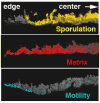Upward mobility and alternative lifestyles: a report from the 10th biennial meeting on Bacterial Locomotion and Signal Transduction
- PMID: 19496930
- PMCID: PMC2724751
- DOI: 10.1111/j.1365-2958.2009.06742.x
Upward mobility and alternative lifestyles: a report from the 10th biennial meeting on Bacterial Locomotion and Signal Transduction
Abstract
This past January, in Cuernavaca Mexico, a conglomerate of scientists met to discuss the contemporary view of Bacterial Locomotion and Signal Transduction (BLAST). The BLAST meetings represent a field that has its roots in chemotaxis and the flagellum-based motility but now encompass all types of cellular movement and signalling. The topics varied from the interactions between molecules to the interactions between species. We heard about 3D reconstructions of transmembrane chemoreceptors within cells, new biophysical methods for understanding cellular engines, intricate phosphorelays, elaborate gene networks, new messenger molecules and emerging behaviours within complex populations of cells. At BLAST X we gained an appreciation for the lifestyle choices bacteria make, how they get to where they are going and the molecular mechanisms that underlie their decisions. Herein we review the highlights of the meeting.
Figures






References
-
- Adler J. Chemotaxis In Bacteria. Annu Rev Biochem. 1975;44:341–356. - PubMed
-
- Aldridge P, Hughes KT. Regulation of flagellar assembly. Curr Opin Microbiol. 2002;5:160–165. - PubMed
-
- Apel D, Surette MG. Bringing order to a complex molecular machine: The assembly of the bacterial flagella. Biochim Biophys Acta-Biomembr. 2008;1778:1851–1858. - PubMed
MeSH terms
Substances
Grants and funding
LinkOut - more resources
Full Text Sources
Research Materials
Miscellaneous

